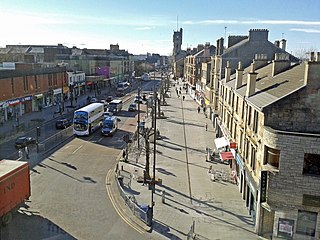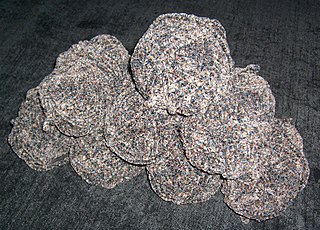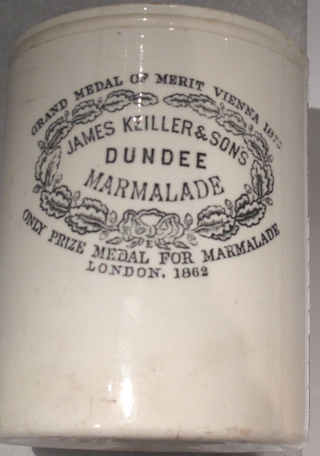
Rutherglen is a town in South Lanarkshire, Scotland, immediately south-east of the city of Glasgow, three miles from its centre and directly south of the River Clyde. Having previously existed as a separate Lanarkshire burgh, in 1975 Rutherglen lost its own local council and administratively became a component of the City of Glasgow District within the Strathclyde region. In 1996 the towns were reallocated to the South Lanarkshire council area.
Rose's lime juice, often known simply as Rose's, is a sweetened concentrated fruit juice patented in 1867. This was the world's first commercially produced fruit concentrate.

The Argyle Line is a suburban railway located in West Central Scotland. The line serves the commercial and shopping districts of Glasgow's central area, and connects towns from West Dunbartonshire to South Lanarkshire. Named for Glasgow's Argyle Street, the line uses the earlier cut-and-cover tunnel running beneath that thoroughfare.

Glasgow Green is a park in the east end of Glasgow, Scotland, on the north bank of the River Clyde. Established in the 15th century, it is the oldest park in the city. It connects to the south via the St Andrew's Suspension Bridge.

Bridgeton is a district to the east of Glasgow city centre. Historically part of Lanarkshire, it is bounded by Glasgow Green to the west, Dalmarnock to the east and south, Calton to the north-west at Abercromby Street/London Road and Broad street to the north-east.
Glasgow Bridgeton was a parliamentary constituency in the city of Glasgow. From 1885 to 1974, it returned one Member of Parliament (MP) to the House of Commons of the Parliament of the United Kingdom, elected by the first-past-the-post voting system.

Chenille is a type of yarn, or the fabric made from it. Chenille is the French word for caterpillar whose fur the yarn is supposed to resemble.
Dalmarnock is a district in the Scottish city of Glasgow. It is situated east of the city centre, directly north of the River Clyde opposite the town of Rutherglen. It is also bounded by the Glasgow neighbourhoods of Parkhead to the north-east and Bridgeton to the north-west.

Burnside is a mostly residential area in the town of Rutherglen in South Lanarkshire, Scotland. Including the neighbourhoods of High Burnside and High Crosshill, respectively south and north-west of its main street, it borders Overtoun Park in Rutherglen plus several other residential areas of the town, as well as western parts of neighbouring Cambuslang.

Keiller's marmalade is named after its creators James and Janet Keiller, and is believed to have been the first commercial brand of marmalade in Great Britain. It was made by James Keiller in Dundee, Scotland, later creating James Keiller & Son, a brand name which became iconic in the 18th and 19th centuries, and has been sold several times.
William Quarrier was a shoe retailer and philanthropist from Glasgow, Scotland. He was founder of the Orphan Homes of Scotland in Renfrewshire, which later evolved into the social care charity Quarriers.

Templeton On The Green, converted from the Templeton Carpet Factory, is a distinctive building near the People's Palace, in Glasgow, Scotland, opened in 1892. In 1984 it was converted into the Templeton Business Centre, then in 2005 a major regeneration project made it into a mixed use 'lifestyle village' incorporating apartments, office space, and the WEST brewery, bar and restaurant.

The A749 road in Scotland connects East Kilbride with Glasgow city centre via Rutherglen and Bridgeton.
Sir John Train was Scottish politician who was a Unionist Party MP for Glasgow Cathcart. He was first elected in 1929, and held the seat until his death in 1942. He was knighted in the 1936 New Year Honours for political services.
Sir Charles Bine Renshaw, 1st Baronet was a Scottish Conservative and Unionist Party politician.

William Leiper FRIBA RSA (1839–1916) was a Scottish architect known particularly for his domestic architecture in and around the town of Helensburgh. In addition, he produced a small amount of fine ecclesiastical and commercial architecture in Glasgow and the Scottish Lowlands. He was also an accomplished watercolour artist, and from the late 1870s spent much spare time painting in oils and watercolours.
The Switchback was a railway line in the East End of Glasgow, Scotland, constructed by the Caledonian Railway (CR). Connecting the lines at Rutherglen on the south side of the city with Robroyston on the north side, this route also served a number of industrial sidings and rail yards.

Shawfield is an industrial/commercial area of the Royal Burgh of Rutherglen in South Lanarkshire, Scotland, located to the north of the town centre. It is bordered to the east by the River Clyde, to the north by the Glasgow neighbourhood of Oatlands and the adjacent Richmond Park, to the south-west by Glasgow's Polmadie and Toryglen districts, and to the south-east by Rutherglen's historic Main Street and its Burnhill neighbourhood, although it is separated from these southerly areas by the West Coast Main Line railway tracks and the M74 motorway. A road bridge connects Shawfield to the Dalmarnock, Bridgeton and Glasgow Green areas.

The Rutherglen Bridge or the Shawfield Bridge is a bridge which was built 1893–96, which crosses the River Clyde, in Scotland.

Arthur Francis Stoddard (1810–1882) was an American-born entrepreneur and philanthropist who founded Stoddard Carpets, Scotland's largest carpet company in the 19th century and a specialist in "tapestry carpets". The company later became Stoddard International.
Fred H. Young, A Century of Carpet Making 1839–1939, Collins, Glasgow, c.1940s














